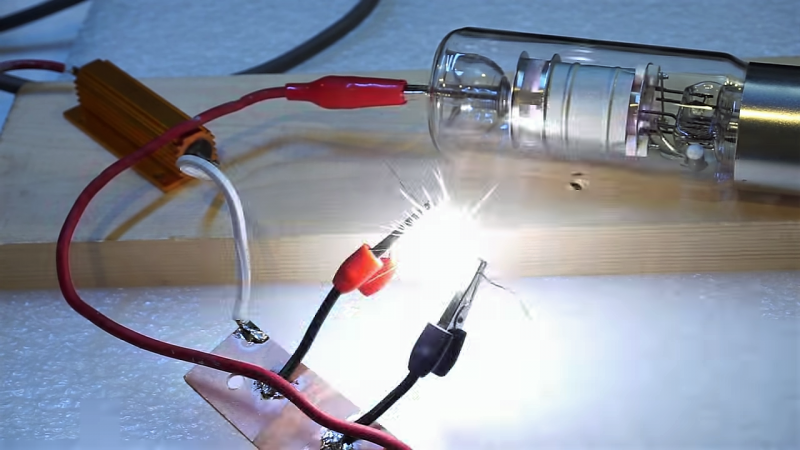There’s something oddly menacing about some vacuum tubes. The glass, the glowing filaments, the strange metal grids and wires suspended within – all those lead to a mysterious sci-fi look and the feeling that strange things are happening in there.
Add in a little high voltage and a tube that makes its own hydrogen, and you’ve got something extra scary. This hydrogen thyratron ended up being just the thing for [Kerry Wong]’s high-voltage, high-current experiments. One would normally turn to the solid-state version of the thyratron, the silicon controlled rectifier (SCR), to switch such voltages. But the devices needed to handle the 30 amps [Kerry] had in mind were exorbitant, and when the IGBTs he used as a substitute proved a little too fragile he turned to the Russian surplus market for help. There he found a TGI1-50/5 hydrogen thyratron, a tube that has a small hydrogen gas generator inside – thyratrons are actually gas-filled rather than vacuum tubes and switch heavy currents through plasma conduction. [Kerry] set up a demo circuit with a small RC network to provide the fast switching pulse preferred by the thyratron, and proceeded to run 3500 volts through a couple of 1/4-W resistors with predictable results. The video below shows the fireworks.
Can’t get enough of the thyratron’s lovely purple glow? We’ve seen it before on this beautiful old switch-mode power supply. The versatile tubes also helped rebuild the first vocal encryption system.
















I was informed, in no uncertain terms, that Hydrogen Thyratrons are Export Controlled a few years back. Silly Security Officer.. I looked it up later..
Only, Hydrogen/hydrogen-isotope thyratrons of ceramic-metal construction and rate for a peak current of 500 A or more, are under ITAR regulations. The ones I was told to pull from the old ruby lasers did not qualify.. Be careful out there.
Yes, but do you know why :)
They are used for radar transmitters. Which is odd because the Russians probably build better ones.
On some EC-121 radar planes they had one of these that was about 3 feet high. It was located right next to the aisle way and the adjustment pot was behind the tube where it could not be easily reached. It did have a nice purple glow.
The tube itself was only about a little over a foot long. The housing, which was pressurized, was about 3 feet high. It fired off a large 325 pound magnetron that would output 5 megawatts in the lower 400 Mhz frequency range. I was a radar tech aboard those planes. It was an APS-95 radar.
They can also be used for nuclear ignition systems. Yes, the big ones get attention when you start asking about them.
Big ones could also be used in a non-nuclear EMP.
Trinitrotoluene-core inductors made to be only used once, are best for this type fast switching.
Good stories here: https://en.wikipedia.org/wiki/Krytron
When you need a small, high power, instant on nuclear bomb trigger, the Krytron is there for you.
I think to remember there was an issue with them, as it happens they are also used in the shock-wave generator of machines to disintegrate kidney stones. So there was a classical dual-use dilemma.
Sorry pressed report comment instead of replay.
High power pulse lasers use those ceramic Thyratrons. We had thse from L3, think they are rated 30kV & ~30kA.
//Steven
The TGI1-50/5 is a Russian tube though.
From the Nuclear Weapons Archive (export controls, courtesy Oak Ridge National Laboratory) (a) Cold-cathode tubes (including gas krytron tubes and vacuum sprytron tubes), whether gas filled or not, operating similarly to a spark gap, containing three or more electrodes, and having all of the following characteristics: 1.Anode peak voltage rating of 2500 V or more, 2.Anode peak current rating of 100 A or more, 3.Anode delay time of 10 microsecond or less, and (b) Triggered spark-gaps having an anode delay time of 15 microsecond or less rated for a peak current of 500 A or more; (c) Modules or assemblies with a fast switching function having all of the following characteristics: 1.Anode peak voltage rating greater than 2000 V; 2.anode peak current rating of 500 A or more; and 3.turn-on time of 1 microsecond or less.
I work with 45kV/9kA rated thyratrons as big as my forearm in our TEA lasers. We run ours at 36kV/7.5 kA, 270MW peak pulsed power!!! I didn’t even know what laser ablation was before I started using it to vaporize sapphire and other ceramics. All that power though, it can’t cut aluminum foil…
Put a layer of Kapton tape on your Aluminum foil first. The laser will blast through it as if it wasn’t there.
Should work on block aluminum and steel as well.
Bring Our Tubes Back Home! :-p But seriously have we lost our ability to make tubes? Maybe there’s a lesson here about declaring “buggy-whip” too soon.
https://wp.me/paMnvJ-N
Here’s a schematic in case someone wants to make bigger holes in aluminum foil. 35 MW pulses oughta do it. But with a ceramic thyratron like the 7890 you don’t see the purple glow. https://www.slac.stanford.edu/pubs/slacpubs/1250/slac-pub-1301.pdf
Looks alot like the PFN from a linac, linear accelerator
Ahhh the purple glow. I used to work on a surface search radar that had a ceramic thyratron that by looking at how far down the purple glow had migrated I could tell about how close I was to replacement; the further down the body, the closer one was to replacement time.
A tube with integrated wear indicator. Nice!